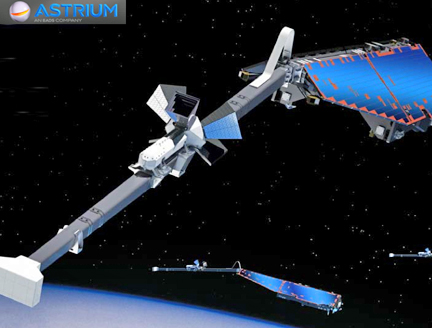[SatNews] Pre-launch preparations for the Swarm satellite cluster-developed and built by Astrium, the world's second largest space company are in full swing at Russia's Plesetsk Cosmodrome, roughly 800km northeast of Moscow.
The three satellites, set to be launched on November 22, 2013, by Eurockot Launch Services using a single launcher, are ready to be mounted on the rocket's upper stage.
Astrium is the European Space Agency's (ESA) prime contractor for the Swarm mission. The purpose of the Swarm mission is to analyze, in unprecedented detail, the geomagnetic field and its evolution. The findings will help improve our understanding of the Earth's inner workings and its interaction with the space environment.
The three identical Swarm satellites will be launched into a polar orbit at an altitude of 490 kilometers and will carry out the most accurate survey to date of the Earth's magnetic field and its changes. Swarm will, in a manner of speaking, follow in the footsteps of Jules Verne's novel "Journey to the Center of the Earth." Today, however, it is not always necessary to dig or drill to take a closer look at the composition and workings of the Earth's interior. Thanks to the development of 'satellite remote sensing,' Swarm can achieve this goal from orbit. The Earth's gravitational and magnetic fields offer direct insights into the workings of its interior: From the variations these fields display at different times and places, scientists can draw conclusions about the dynamic processes taking place deep beneath the planet's surface, in the outer core.
Extremely accurate, high-resolution readings of the geomagnetic field's strength, orientation and fluctuations, complemented by precise navigation and velocity data, along with measurements of the electric field intensity, will provide the observational data required to distinguish between the various sources of the geomagnetic field and to explain them through models. Swarm's high-resolution magnetic field measurements will also serve to map magnetized rock formations and sediments, as well as to help discover minerals and ore deposits.
In addition to the magnetic field, the Swarm trio will also study the upper atmosphere, which is partly ionized and electrically conductive. Fluctuations in the electron density can scatter radio waves and interfere with or jam navigation signals. The Swarm satellite fleet can detect areas showing such phenomena. Swarm can as such also contribute to enhancing the safety of air travel.
A further major challenge is the observation of ocean currents. The movement of electrically charged salt water generates a weak magnetic field. The Swarm mission should make it possible to observe large-area ocean currents over greater distances and periods. The dynamic of the oceans plays a major role in global climate. Swarm can make an important contribution to climate research by detecting patterns of global ocean circulation.
Astrium began developing its first satellite for magnetic field research in deep space the ISEE-B back in the late 1970s. This work has continued with the development of the four-satellite Cluster constellation which has been in orbit and operating since 2000. In the field of low Earth orbit satellites, the German Champ satellite, which collected data from 2000 to 2010, was built to an Astrium design. The Swarm constellation is now the logical next step down this path. In terms of technology, Swarm has benefited from the legacy of both the Champ satellite and Cryosat, the polar ice research satellite both projects led by Astrium. When it comes to overall system design, individual subsystems and test ranges, Astrium's satellite builders can draw on the wealth of experience they gained in these earlier projects.
Astrium and ESA's Earth observation program Swarm is the 'Three-satellite-mission' in ESA's Earth observation program. Its mission is to study the Earth's magnetic field. In its role as industrial prime contractor, Astrium (Friedrichshafen) is responsible for developing and building the Swarm satellites.
Astrium is also actively involved in developing other satellites for ESA's Earth Explorer missions. The company is the prime contractor for the EarthCARE Earth observation satellite which is currently under construction and for the ADM-Aeolus wind mission. Furthermore, Astrium built the Cryosat-2 ice research satellite, which was launched on April 8, 2010. Astrium also supplied the platform for GOCE, which successfully 'surfed' and measured the Earth's gravitational field since March 17, 2009. Astrium also developed and built the Miras payload for the SMOS mission for the observation of soil moisture and salinity over the oceans, which was launched on November 2, 2009.


